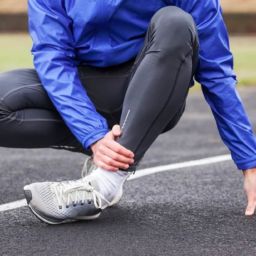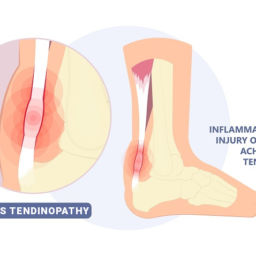
The Achilles tendon is a band of tissue going from the heel bone to the calf. It’s a crucial tendon for walking, running, and jumping. Just going through daily activities can put pressure and stress on your tendon. If the tendon experiences irritation, pain, and swelling, these are signs you may need Achilles tendon injury treatment.
Achilles Tendon Problems
The two main Achilles tendon issues are tendonitis and tendon ruptures. Below, you can learn more about each of these injuries and what to expect from them.
Tendonitis
Tendonitis is an Achilles injury due to damage or overuse. With tendonitis, pain may occur in the back of the leg or near the heel. The tendon can also harden and thicken over time. Without treatment from a physical therapist, the problem will get worse. Two types of tendonitis exist:
- Non-insertional Achilles tendonitis: This occurs when the middle fibers of the tendon begin to break down. You can expect to feel swelling and pain. This form of tendonitis is most common in young, active adults.
- Insertional Achilles tendonitis: Damage here happens at the heel bone and tendon. In most cases, extra bone growth (bone spurs) also forms at this time. This tendonitis type occurs in those of all ages and activity levels.
Ruptures
Another injury is an Achilles tendon rupture. Tendon ruptures consist of a partial or complete tear in the tendon. A pop may be heard from the back of the calf or heel when the injury occurs. If this is the case, a physical exam and treatment should be provided immediately.
Common Symptoms of Achilles Tendon Problems
There are many symptoms of an injury to the Achilles tendon. Some you may experience include the following:
- Pain located near the heel or on the back of the leg
- A popping sound followed by a sharp pain in the case of a ruptured tendon
- Pain that continues to get worse when active
- Trouble flexing the injured foot
- A sore and stiff Achilles tendon when waking up in the morning
- Bone spurs located on the heel bone
- Pain located in the tendon the day after exercising
- Thickening of the tendon
- Swelling with pain that gets more pronounced while active throughout the day
Risk Factors for Achilles Tendon Injuries
Achilles tendon injuries can happen to anyone. Repetitive stress is the most common cause. However, there are other risk factors, including the below:
- Bone spurs on the heel
- Increased activities or more intense sports
- Tight calf muscles during exercise
- Wearing inappropriate shoes for exercise
- Exercising on uneven surfaces
- Using fluoroquinolone as an antibiotic
Options to Prevent Achilles Tendon Injuries
There are a variety of methods to avoid injury to the Achilles tendon, including the following:
- Always warm up the body before sports, exercises, or repetitive movement.
- Slowly increase activity instead of going full steam to begin.
- Make sure to wear the proper shoes for what you are doing.
- Don’t exercise on uneven surfaces.
- Avoid activities that cause pain.
- Exercise using caution if you are using fluoroquinolone.
Diagnosis of Achilles Tendon Problems
An injury in the Achilles tendon will create pain at the back of the leg close to the heel. In some cases, this can be misdiagnosed as a sprained ankle instead of an Achilles tendon injury. The appropriate diagnosis is key to Achilles tendon injury treatment. A variety of injuries can create pain in the Achilles tendon or prevent it from working the way it should.
A sports medicine doctor can diagnose Achilles tendon injuries. The expert will ask about your medical history and health and let you describe your symptoms. A physical exam will be done to look for swelling, pain, and bone spurs. Tests of the range of motion of the ankle, as well as imaging tests, may also be a part of the process.
Magnetic resonance imaging or X-rays may be done. X-rays look at the bones and can see if the tendon is hardened, calcified, or has bone spurs. An MRI is typically used to determine how serious the damage to the tendon is and which form of treatment is best for your needs.
Achilles Tendon Injury Treatment
Treatment will depend on the degree of injury to the tendon. Rest, ice, and nonsteroidal anti-inflammatory drugs may be recommended. Physical therapy may be needed to strengthen the calf muscles. Low-impact exercises may also be helpful. You may need to do a set of specific exercises to create stronger calf muscles.
Some individuals may need casts, splints, or walking boots to prevent further injury. Shockwave therapy can also be used to stimulate healing in the damaged tissue. This is a rare option but may be recommended to determine if healing can occur without surgical intervention.
If these treatments do not work, several surgeries can be used to remove damage to the tendon. Gastrocnemius recession can be used to lengthen the calf muscles. Debridement surgery can be used to remove bone spurs or damaged tissue while repairing the tendon. There is also a surgery to remove and repair tissue and provide extra strength to it by moving another tendon to the heel bone.
Seek Achilles Tendon Injury Treatments in South Florida
Certified Foot & Ankle Specialists has 20 locations that can help you prevent Achilles tendon issues and treat any problems you have now. We’re located in Boca Raton, Ft. Lauderdale, Pembroke Pines, and more for Achilles tendon injury treatments. To make an appointment, click here.


